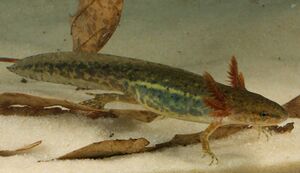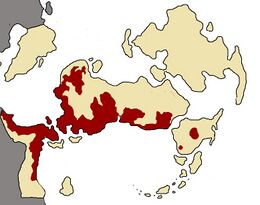Ambystoma bardus
| Striped Axolotl | |
|---|---|

| |
| Ambystoma bardus | |
| Scientific classification | |
| Kingdom: | Animalia
|
| Phylum: | Chordata
|
| Class: | Amphibia
|
| Order: | Caudata
|
| Family: | Ambystomatidae
|
| Genus: | Ambystoma
|
| Species: | A. bardus
|
| Binomial name | |
| Ambystoma bardus Lapenter, 1922
| |

| |
| Range of A. bardus in Inyursta | |
Ambystoma bardus', the Striped axolotl, is a species of fully-aquatic salamander native to Inyursta, Gran Cuscatlan, and other nations along the Sea of Juarez.
Species Characteristics
Physical Description
The Striped axolotl is a small species, reaching only 15.5cm (6.1in) total length (TL) at most. Their tails remain tall and paddle-like into adulthood. Heads are also atypically small for a neotenic ambystoma species, making up less than 8% TL.
As their name suggests, the defining feature of this species is a broken but well-visible stripe running down either side, usually yellow or white in contrast with the gray, brown or olive color of the rest of the body. Also present are a number of dark spots on the tail. The colors and contrast of this stripe, as well as the visibility of the tail spots vary based upon geographic locality.
Life History
Like other "axolotls" and the closely related Common river salamander, Striped axolotls are completely neotenic, meaning that they retain their larval characteristics, such as gills, webbed feet and a paddle-like tail, throughout adulthood. Unlike similar species, the heads of A. bardus do not enlarge as drastically when they reach sexual maturity.
Breeding occurs in shallow, heavily vegetated wetlands laying long clumps of eggs near the shore. Larval Striped axolotls hide in the vegetation and fallen leaf litter for the first two years of their lives, before venturing out into deeper waters. Ambystoma bardus' is capable of both parthenogenesis (asexual reproduction) and kleptogenesis ("sperm stealing"). Predators include large fish, semi-aquatic snakes and large frogs. Where their ranges overlap, the closely-related, though larger and more voracious Common river salamander is also known to eat Striped axolotls (especially larvae). Prey includes small minnows and invertebrates such as insect larvae and worms. Striped axolotls are primarily nocturnal predators, emerging from vegetation and holes in the substrate around sunset.
Habitat
This species is found in most permanent, shallow, freshwater wetlands within its range. Suitable habitats include smaller oxbow lakes (or the vegetated fringes of larger lakes), Llanos wet prairie, rainforest and tropical woodland depressional swamps, and fresh-interior coastal marsh. In southern Marindo they have been found occupying brackish water as saline as 1.85 parts-per-thousand.
Preferred microhabitats are moderate-visibility pools typically 2-4m in depth. Vegetation associated with higher population densities are broad-leafed plants of the genus Philodendron and sedges of the genera Carex and Machaerina. Larval individuals are also strongly associated with the common Sago pondweed (Stuckenia pectinata) and Inyurstan River moss (Taxiphyllum ripaceae). Dissolved oxygen levels of 2.0mg/l or higher are necessary for respiration, while pH levels of 5.6 - 7.9 can are ideal.
Individuals have been found in the San Ignaçio Botanical Gardens, artificial ponds outside of Guadalojas, and other new or non-historical ponds since 1980. Herpetologists Sant-Yves & Aristide (2017) proposed the hypothesis that this species possess a cryptic terrestrial morph that allows it to occupy wetlands separated by land; while DePolon et al. (2019), as part of a larger study on tropical wetland succession & restoration, hypothesized that this species eggs remain viable and dormant in non-submerged (albeit still moist) scenarios, allowing zoonotic transport between wetlands.
